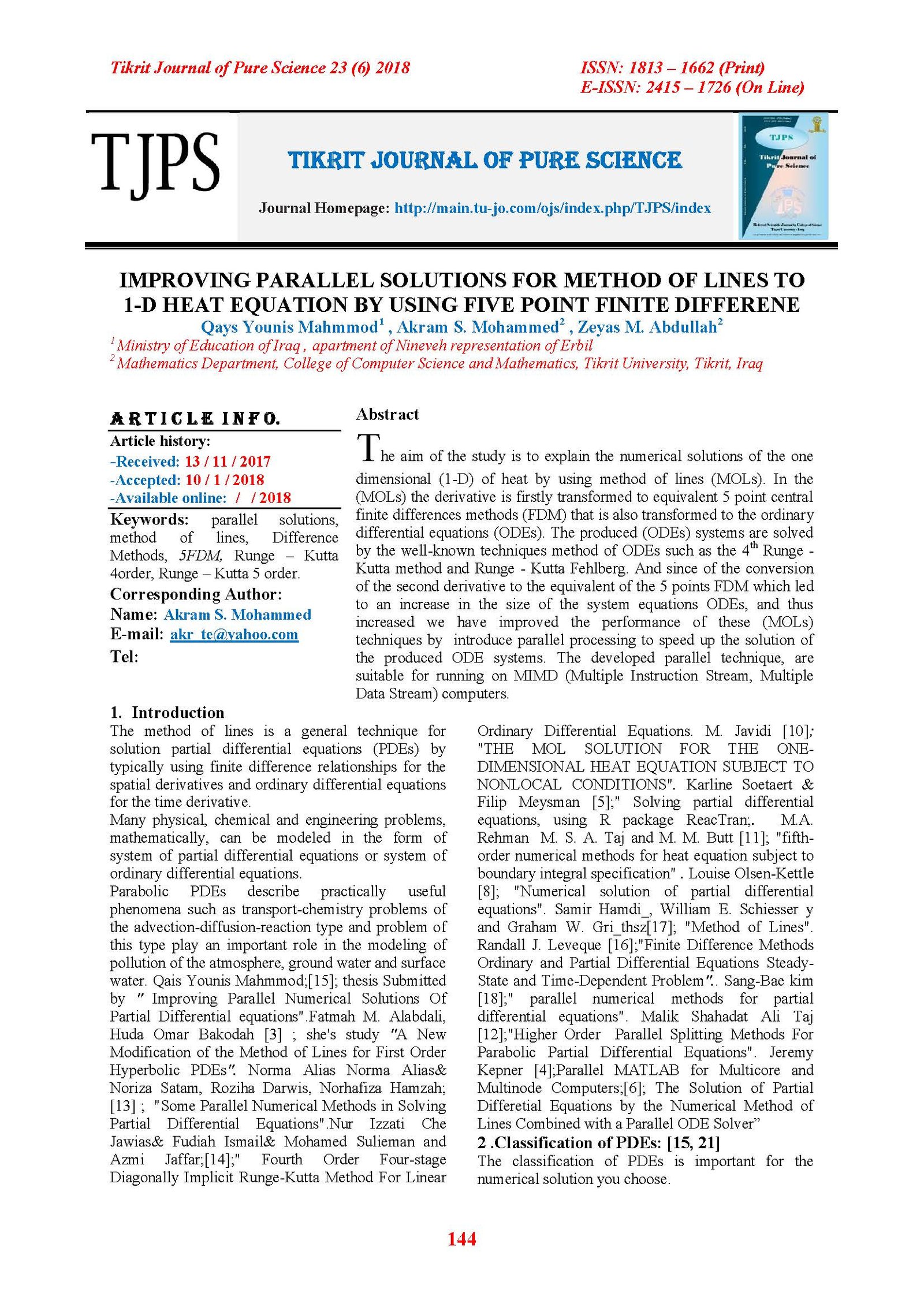IMPROVING PARALLEL SOLUTIONS FOR METHOD OF LINES TO 1-D HEAT EQUATION BY USING FIVE POINT FINITE DIFFERENE
Main Article Content
Abstract
The aim of the study is to explain the numerical solutions of the one dimensional (1-D) of heat by using method of lines (MOLs). In the (MOLs) the derivative is firstly transformed to equivalent 5 point central finite differences methods (FDM) that is also transformed to the ordinary differential equations (ODEs). The produced (ODEs) systems are solved by the well-known techniques method of ODEs such as the 4th Runge - Kutta method and Runge - Kutta Fehlberg. And since of the conversion of the second derivative to the equivalent of the 5 points FDM which led to an increase in the size of the system equations ODEs, and thus increased we have improved the performance of these (MOLs) techniques by introduce parallel processing to speed up the solution of the produced ODE systems. The developed parallel technique, are suitable for running on MIMD (Multiple Instruction Stream, Multiple Data Stream) computers.
Article Details

This work is licensed under a Creative Commons Attribution 4.0 International License.
Tikrit Journal of Pure Science is licensed under the Creative Commons Attribution 4.0 International License, which allows users to copy, create extracts, abstracts, and new works from the article, alter and revise the article, and make commercial use of the article (including reuse and/or resale of the article by commercial entities), provided the user gives appropriate credit (with a link to the formal publication through the relevant DOI), provides a link to the license, indicates if changes were made, and the licensor is not represented as endorsing the use made of the work. The authors hold the copyright for their published work on the Tikrit J. Pure Sci. website, while Tikrit J. Pure Sci. is responsible for appreciate citation of their work, which is released under CC-BY-4.0, enabling the unrestricted use, distribution, and reproduction of an article in any medium, provided that the original work is properly cited.
References
[1] Alkis Gonstantinides & Navid Mostoufi;(1999);
Numerical Methods for Chemical Engineers with
MATLAB Applications; by Prentice hall PTR ISBN
0-13-013851-7. [8]
[2]Daniel R. Lynch;(2005); NUMERICAL
PARTIAL DIFFERENTIAL EQUATIONS FOR
ENVIRONMENTAL SCIENTISTS AND
ENGINEERS A First Practical Course; 2005 Springer
Science + Business Media, Inc..
[3] Fatmah M. Alabdali, Huda Omar Bakodah;
(2014); A New Modification of the Method of Lines
for First Order Hyperbolic PDEs; Applied
Mathematics, 2014, 5, 1457-1462 Published Online
June 2014 in Sci Res. http://www.scirp.org/journal/am.
[4] Jeremy Kepner;(2009); "Parallel MATLAB for
Multicore and Multinode Computers"; by the Society
for Industrial and Applied Mathematics (SIAM);
ISBN 978-0-898716-73-3.
[5] Karline Soetaert & Filip Meysman; (2010);
Solving partial differential equations, using R
package Reac Tran;
http://www.nioo.knaw.nl/ppages/ksoetaert.
[6] Khaddaj, S. A. and Liddell, H. M., (1990), “The
Solution of Partial Differetial Equations by the
Numerical Method of Lines Combined with a Parallel
ODE Solver”, Numerical Methods in Engineering:
Theory and Applications, Vol. I, Edited by Pande, G.
N. and Middleton, J., University College of Swansea
Elsevier Applied Science Publisher Ltd..
[7] Leon Lapidus &G eorge F. pinder; (1999);
NUMERICAL SOLUTION OF ARTIAL
DIFFERENTIAL EQUATIONS IN SCIENCE AND
ENGINEERING; by John Wiley & Sons, Inc. All
rights reserved ISBN 0-471-35944-0 .
[8]Louise Olsen-Kettle; Numerical solution of partial
differential equations.
http://researchers.uq.edu.au/researcher/768.
[9]M. AKRAM ; (2005); A parallel algorithm for the
inhomogeneous heat equations; University College of
Information Technology, Punjab University, Old
Campus, Lahore-54000, Pakistan; J. Indian Inst. Sci.,
Sep.–Oct. 2005, 85, 253–264.
[10] M. Javidi; (2006);" THE MOL SOLUTION
FOR THE ONE-DIMENSIONAL HEAT
EQUATION SUBJECT TO NONLOCAL
CONDITIONS"; Kermanshah 67149, Iran;
International Mathematical Forum, 1, 2006, no. 12,
597-602.
[11] M.A. Rehman M. S. A. Taj and M. M. Butt
;(2010); FIFTH-ORDER NUMERICAL METHODS
FOR HEAT EQUATION SUBJECT TO A
BOUNDARY INTEGRALSPECIFICATION; Acta
Math. Univ. Comenianae Vol. LXXIX, 1(2010), pp.
89-104.
[12] Malik Shahadat Ali Taj;(1995); Higher Order
Parallel Splitting Methods For Parabolic Partial
Differential Equations"; thesis submitted for the
degree of Doctor of Philosophy Uxbridge, Middlesex,
England. UB8 3PH.
[13] Norma Alias; (2010); "Some Parallel Numerical
Methods in Solving Partial Differential
Equations";V2-396 2010 2nd International
Conference on Computer Engineering and
Technology.
[14]Nur Izzati Che Jawias& Fudiah Ismail&
Mohamed Sulieman and Azmi Jaffar; "Fourth Order
Four-stage Diagonally Implicit Runge-Kutta Method
For Linear Ordinary Differential Equations";
Malaysian Journal of Mathematical Sciences 4(1):95-
`05(2010).
[15] Qais Younis Mahmmod; (2013); Improving
Parallel Numerical Solutions Of Partial Differential
equations; thesis Submitted to The Council of the
College of Education,University of Mosul.
[16] Randall J. Leveque;(2007); Finite Difference
Methods for Ordinary and Partial Differential
Equations Steady-State and Time-Dependent
Problems; by the Society for Industrial and Applied
Mathematics.
[17] Samir Hamdi & William E. Schiesser y and
Graham W. Gri_thsz; (2009); Method of Lines; Ecole
Polytechnique, France; Lehigh University, USA; City
University,UK; Scholarpedia, 2(7):2859.
[18] Sang-Bae kim;(1993);" parallel numerical
methods for partial differential equations"; thesis of
Purdue University in partial requirements for the
degree of doctor of philosophy.
[19] Timothy Sauer ; (2012); NUMERICAL Analysis second edition; By Pearson Education, Inc. ISBN-13: 978-0-321-78367-7.
[20] VICTOR J. Law; (2013); NUMERICAL METHODS for CHEMICAL ENGINEERS Using Excel , VBA, and MATLAB; by Taylor & Francis Group, LLC Boca Raton, FL 33487-2742.
[21] William E. Schiesser & Graham W. Griffiths ; (2009) ; A Compendium of Partial Differential Equation Models: Method of Lines Analysis with Matlab; ISBN-13 978-0-511-50853-0.
